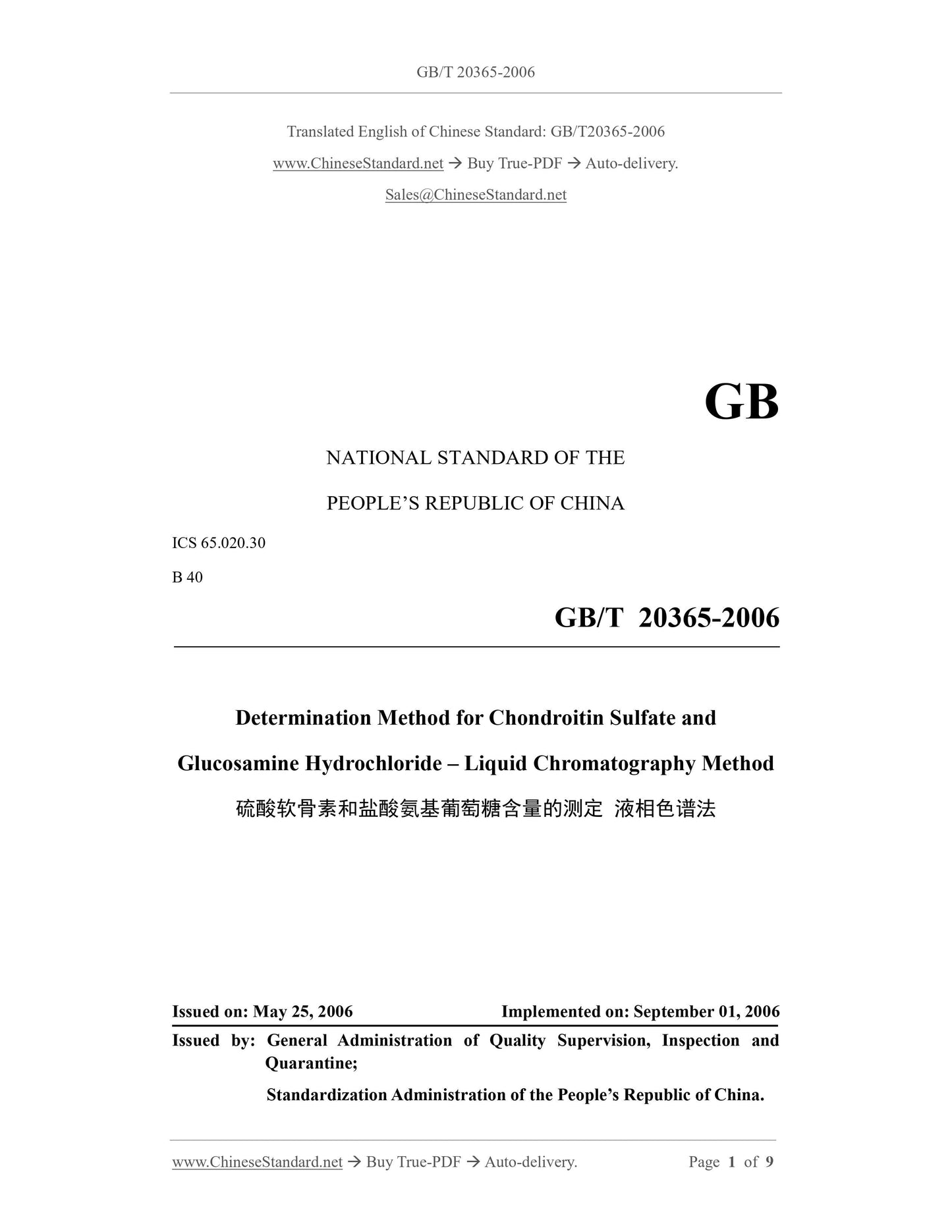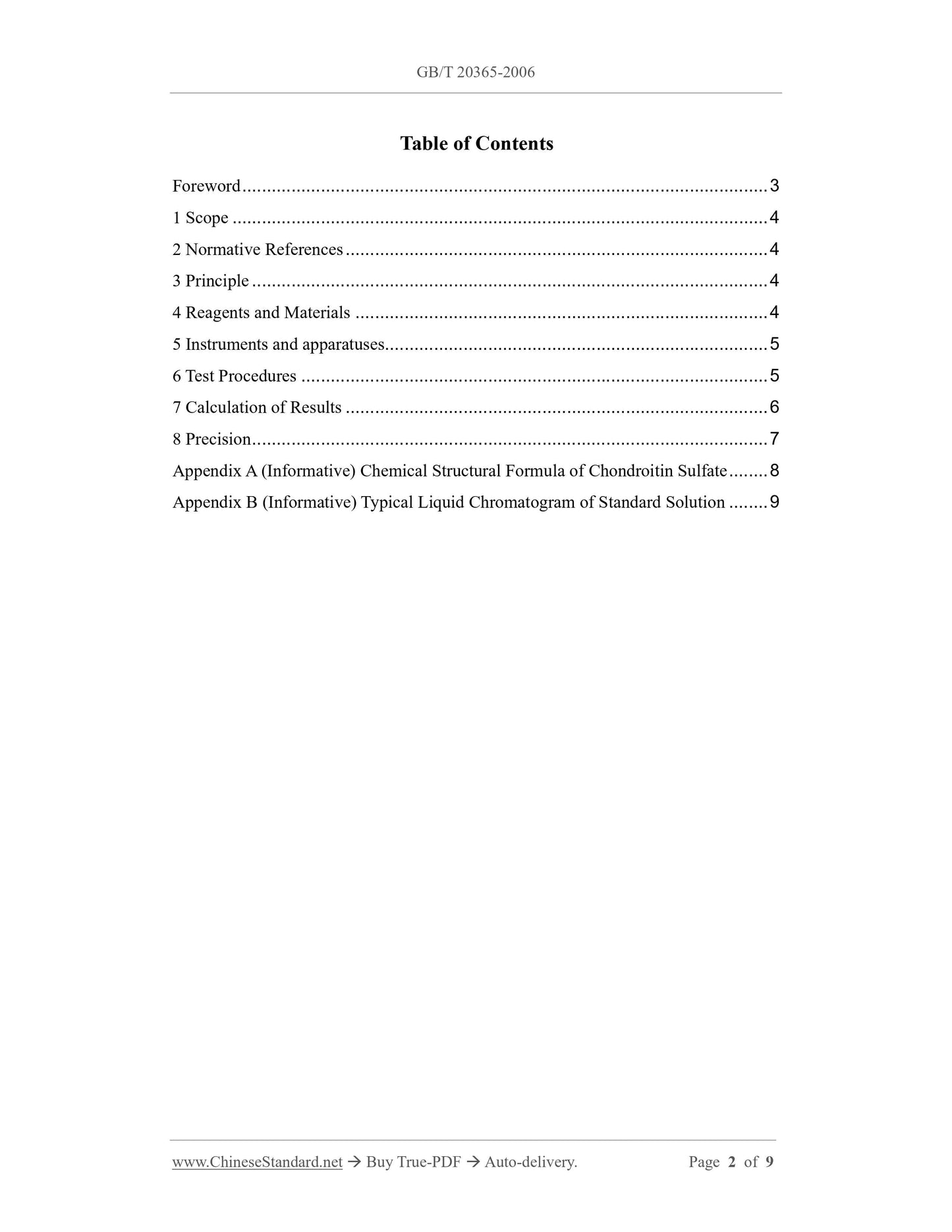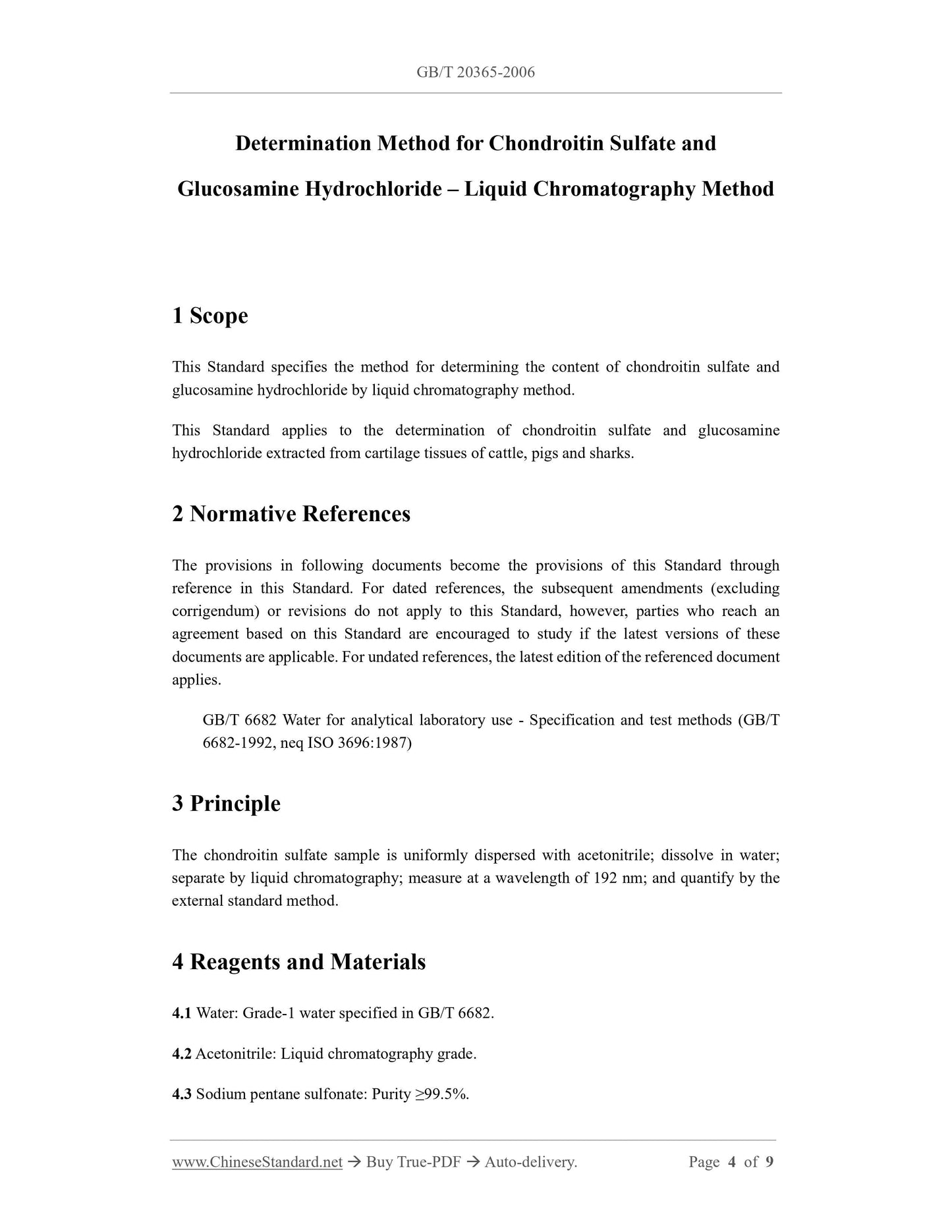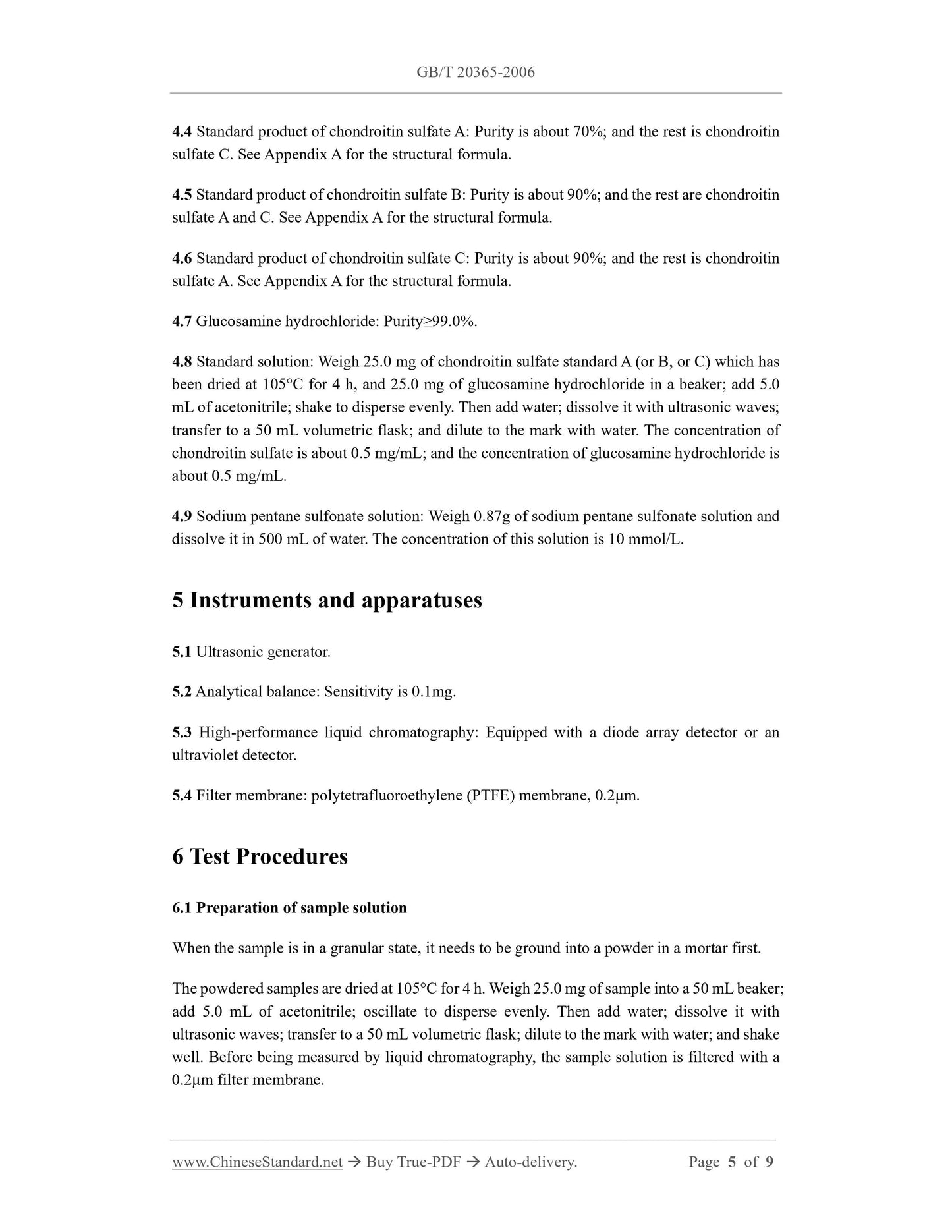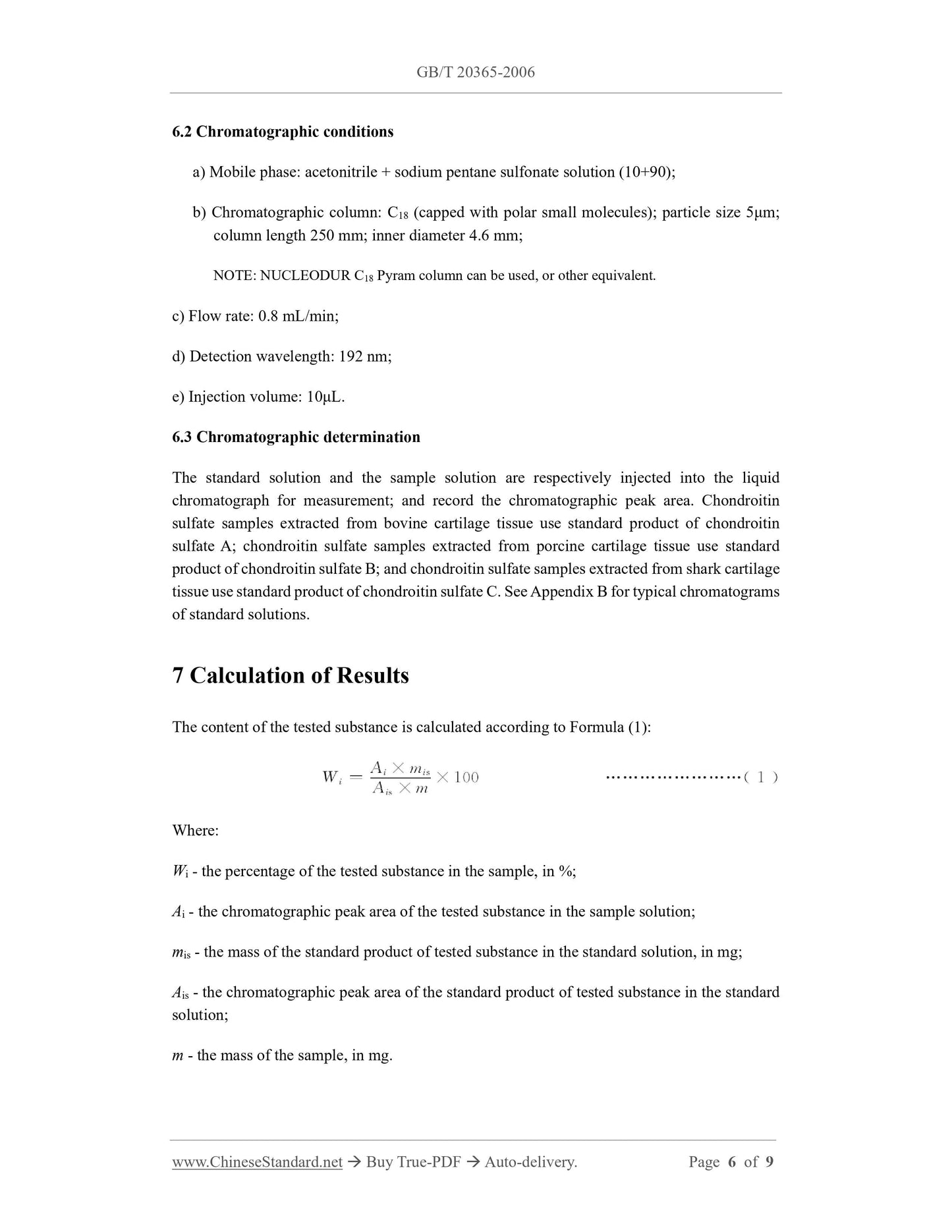1
/
of
5
www.ChineseStandard.us -- Field Test Asia Pte. Ltd.
GB/T 20365-2006 English PDF (GB/T20365-2006)
GB/T 20365-2006 English PDF (GB/T20365-2006)
Regular price
$145.00
Regular price
Sale price
$145.00
Unit price
/
per
Shipping calculated at checkout.
Couldn't load pickup availability
GB/T 20365-2006: Determination method for chondroitin sulfate and glucosamine hydrochloride -- Liquid chromatography method
Delivery: 9 seconds. Download (& Email) true-PDF + Invoice.
Get Quotation: Click GB/T 20365-2006 (Self-service in 1-minute)
Historical versions (Master-website): GB/T 20365-2006
Preview True-PDF (Reload/Scroll-down if blank)
GB/T 20365-2006
GB
NATIONAL STANDARD OF THE
PEOPLE’S REPUBLIC OF CHINA
ICS 65.020.30
B 40
Determination Method for Chondroitin Sulfate and
Glucosamine Hydrochloride – Liquid Chromatography Method
ISSUED ON: MAY 25, 2006
IMPLEMENTED ON: SEPTEMBER 01, 2006
Issued by: General Administration of Quality Supervision, Inspection and
Quarantine;
Standardization Administration of the People’s Republic of China.
Table of Contents
Foreword ... 3
1 Scope ... 4
2 Normative References ... 4
3 Principle ... 4
4 Reagents and Materials ... 4
5 Instruments and apparatuses ... 5
6 Test Procedures ... 5
7 Calculation of Results ... 6
8 Precision ... 7
Appendix A (Informative) Chemical Structural Formula of Chondroitin Sulfate ... 8
Appendix B (Informative) Typical Liquid Chromatogram of Standard Solution ... 9
Determination Method for Chondroitin Sulfate and
Glucosamine Hydrochloride – Liquid Chromatography Method
1 Scope
This Standard specifies the method for determining the content of chondroitin sulfate and
glucosamine hydrochloride by liquid chromatography method.
This Standard applies to the determination of chondroitin sulfate and glucosamine
hydrochloride extracted from cartilage tissues of cattle, pigs and sharks.
2 Normative References
The provisions in following documents become the provisions of this Standard through
reference in this Standard. For dated references, the subsequent amendments (excluding
corrigendum) or revisions do not apply to this Standard, however, parties who reach an
agreement based on this Standard are encouraged to study if the latest versions of these
documents are applicable. For undated references, the latest edition of the referenced document
applies.
GB/T 6682 Water for analytical laboratory use - Specification and test methods (GB/T
6682-1992, neq ISO 3696:1987)
3 Principle
The chondroitin sulfate sample is uniformly dispersed with acetonitrile; dissolve in water;
separate by liquid chromatography; measure at a wavelength of 192 nm; and quantify by the
external standard method.
4 Reagents and Materials
4.1 Water: Grade-1 water specified in GB/T 6682.
4.2 Acetonitrile: Liquid chromatography grade.
4.3 Sodium pentane sulfonate: Purity ≥99.5%.
4.4 Standard product of chondroitin sulfate A: Purity is about 70%; and the rest is chondroitin
sulfate C. See Appendix A for the structural formula.
4.5 Standard product of chondroitin sulfate B: Purity is about 90%; and the rest are chondroitin
sulfate A and C. See Appendix A for the structural formula.
4.6 Standard product of chondroitin sulfate C: Purity is about 90%; and the rest is chondroitin
sulfate A. See Appendix A for the structural formula.
4.7 Glucosamine hydrochloride: Purity≥99.0%.
4.8 Standard solution: Weigh 25.0 mg of chondroitin sulfate standard A (or B, or C) which has
been dried at 105°C for 4 h, and 25.0 mg of glucosamine hydrochloride in a beaker; add 5.0
mL of acetonitrile; shake to disperse evenly. Then add water; dissolve it with ultrasonic waves;
transfer to a 50 mL volumetric flask; and dilute to the mark with water. The concentration of
chondroitin sulfate is about 0.5 mg/mL; and the concentration of glucosamine hydrochloride is
about 0.5 mg/mL.
4.9 Sodium pentane sulfonate solution: Weigh 0.87g of sodium pentane sulfonate solution and
dissolve it in 500 mL of water. The concentration of this solution is 10 mmol/L.
5 Instruments and apparatuses
5.1 Ultrasonic generator.
5.2 Analytical balance: Sensitivity is 0.1mg.
5.3 High-performance liquid chromatography: Equipped with a diode array detector or an
ultraviolet detector.
5.4 Filter membrane: polytetrafluoroethylene (PTFE) membrane, 0.2μm.
6 Test Procedures
6.1 Preparation of sample solution
When the sample is in a granular state, it needs to be ground into a powder in a mortar first.
The powdered samples are dried at 105°C for 4 h. Weigh 25.0 mg of sample into a 50 mL beaker;
add 5.0 mL of acetonitrile; oscillate to disperse evenly. Then add water; dissolve it with
ultrasonic waves; transfer to a 50 mL volumetric flask; dilute to the mark with water; and shake
well. Before being measured by liquid chromatography, the sample solution is filtered with a
0.2μm filter membrane.
6.2 Chromatographic conditions
a) Mobile phase: acetonitrile + sodium pentane sulfonate solution (10+90);
b) Chromatographic column: C18 (capped with polar small molecules); particle size 5μm;
column length 250 mm; inner diameter 4.6 mm;
NOTE: NUCLEODUR C18 Pyram column can be used, or other equivalent.
c) Flow rate: 0.8 mL/min;
d) Detection wavelength: 192 nm;
e) Injection volume: 10μL.
6.3 Chromatographic determination
The standard solution and the sample solution are respectively injected into the liquid
chromatograph for measurement; and record the chromatographic peak area. Chondroitin
sulfate samples extracted from bovine cartilage tissue use standard product of chondroitin
sulfate A; chondroitin sulfate samples extracted from porcine cartilage tissue use standard
product of chondroitin sulfate B; and chondroitin sulfate samples extracted from shark cartilage
tissue use standard product of chondroitin sulfate C. See Appendix B for typical chromatograms
of standard solutions.
7 Calculation of Results
The content of the tested substance is calculated according to Formula (1):
Where:
Wi - the percentage of the tested substance in the sample, in %;
Ai - the chromatographic peak area of the tested substance in the sample solution;
mis - the mass of the standard product of tested substance in the standard solution, in mg;
Ais - the chromatographic peak area of the standard product of tested substance in the standard
solution;
m - the mass of the sample, in mg.
GB/T 20365-2006
GB
NATIONAL STANDARD OF THE
PEOPLE’S REPUBLIC OF CHINA
ICS 65.020.30
B 40
Determination Method for Chondroitin Sulfate and
Glucosamine Hydrochloride – Liquid Chromatography Method
ISSUED ON: MAY 25, 2006
IMPLEMENTED ON: SEPTEMBER 01, 2006
Issued by: General Administration of Quality Supervision, Inspection and
Quarantine;
Standardization Administration of the People’s Republic of China.
Table of Contents
Foreword ... 3
1 Scope ... 4
2 Normative References ... 4
3 Principle ... 4
4 Reagents and Materials ... 4
5 Instruments and apparatuses ... 5
6 Test Procedures ... 5
7 Calculation of Results ... 6
8 Precision ... 7
Appendix A (Informative) Chemical Structural Formula of Chondroitin Sulfate ... 8
Appendix B (Informative) Typical Liquid Chromatogram of Standard Solution ... 9
Determination Method for Chondroitin Sulfate and
Glucosamine Hydrochloride – Liquid Chromatography Method
1 Scope
This Standard specifies the method for determining the content of chondroitin sulfate and
glucosamine hydrochloride by liquid chromatography method.
This Standard applies to the determination of chondroitin sulfate and glucosamine
hydrochloride extracted from cartilage tissues of cattle, pigs and sharks.
2 Normative References
The provisions in following documents become the provisions of this Standard through
reference in this Standard. For dated references, the subsequent amendments (excluding
corrigendum) or revisions do not apply to this Standard, however, parties who reach an
agreement based on this Standard are encouraged to study if the latest versions of these
documents are applicable. For undated references, the latest edition of the referenced document
applies.
GB/T 6682 Water for analytical laboratory use - Specification and test methods (GB/T
6682-1992, neq ISO 3696:1987)
3 Principle
The chondroitin sulfate sample is uniformly dispersed with acetonitrile; dissolve in water;
separate by liquid chromatography; measure at a wavelength of 192 nm; and quantify by the
external standard method.
4 Reagents and Materials
4.1 Water: Grade-1 water specified in GB/T 6682.
4.2 Acetonitrile: Liquid chromatography grade.
4.3 Sodium pentane sulfonate: Purity ≥99.5%.
4.4 Standard product of chondroitin sulfate A: Purity is about 70%; and the rest is chondroitin
sulfate C. See Appendix A for the structural formula.
4.5 Standard product of chondroitin sulfate B: Purity is about 90%; and the rest are chondroitin
sulfate A and C. See Appendix A for the structural formula.
4.6 Standard product of chondroitin sulfate C: Purity is about 90%; and the rest is chondroitin
sulfate A. See Appendix A for the structural formula.
4.7 Glucosamine hydrochloride: Purity≥99.0%.
4.8 Standard solution: Weigh 25.0 mg of chondroitin sulfate standard A (or B, or C) which has
been dried at 105°C for 4 h, and 25.0 mg of glucosamine hydrochloride in a beaker; add 5.0
mL of acetonitrile; shake to disperse evenly. Then add water; dissolve it with ultrasonic waves;
transfer to a 50 mL volumetric flask; and dilute to the mark with water. The concentration of
chondroitin sulfate is about 0.5 mg/mL; and the concentration of glucosamine hydrochloride is
about 0.5 mg/mL.
4.9 Sodium pentane sulfonate solution: Weigh 0.87g of sodium pentane sulfonate solution and
dissolve it in 500 mL of water. The concentration of this solution is 10 mmol/L.
5 Instruments and apparatuses
5.1 Ultrasonic generator.
5.2 Analytical balance: Sensitivity is 0.1mg.
5.3 High-performance liquid chromatography: Equipped with a diode array detector or an
ultraviolet detector.
5.4 Filter membrane: polytetrafluoroethylene (PTFE) membrane, 0.2μm.
6 Test Procedures
6.1 Preparation of sample solution
When the sample is in a granular state, it needs to be ground into a powder in a mortar first.
The powdered samples are dried at 105°C for 4 h. Weigh 25.0 mg of sample into a 50 mL beaker;
add 5.0 mL of acetonitrile; oscillate to disperse evenly. Then add water; dissolve it with
ultrasonic waves; transfer to a 50 mL volumetric flask; dilute to the mark with water; and shake
well. Before being measured by liquid chromatography, the sample solution is filtered with a
0.2μm filter membrane.
6.2 Chromatographic conditions
a) Mobile phase: acetonitrile + sodium pentane sulfonate solution (10+90);
b) Chromatographic column: C18 (capped with polar small molecules); particle size 5μm;
column length 250 mm; inner diameter 4.6 mm;
NOTE: NUCLEODUR C18 Pyram column can be used, or other equivalent.
c) Flow rate: 0.8 mL/min;
d) Detection wavelength: 192 nm;
e) Injection volume: 10μL.
6.3 Chromatographic determination
The standard solution and the sample solution are respectively injected into the liquid
chromatograph for measurement; and record the chromatographic peak area. Chondroitin
sulfate samples extracted from bovine cartilage tissue use standard product of chondroitin
sulfate A; chondroitin sulfate samples extracted from porcine cartilage tissue use standard
product of chondroitin sulfate B; and chondroitin sulfate samples extracted from shark cartilage
tissue use standard product of chondroitin sulfate C. See Appendix B for typical chromatograms
of standard solutions.
7 Calculation of Results
The content of the tested substance is calculated according to Formula (1):
Where:
Wi - the percentage of the tested substance in the sample, in %;
Ai - the chromatographic peak area of the tested substance in the sample solution;
mis - the mass of the standard product of tested substance in the standard solution, in mg;
Ais - the chromatographic peak area of the standard product of tested substance in the standard
solution;
m - the mass of the sample, in mg.
Delivery: 9 seconds. Download (& Email) true-PDF + Invoice.
Get Quotation: Click GB/T 20365-2006 (Self-service in 1-minute)
Historical versions (Master-website): GB/T 20365-2006
Preview True-PDF (Reload/Scroll-down if blank)
GB/T 20365-2006
GB
NATIONAL STANDARD OF THE
PEOPLE’S REPUBLIC OF CHINA
ICS 65.020.30
B 40
Determination Method for Chondroitin Sulfate and
Glucosamine Hydrochloride – Liquid Chromatography Method
ISSUED ON: MAY 25, 2006
IMPLEMENTED ON: SEPTEMBER 01, 2006
Issued by: General Administration of Quality Supervision, Inspection and
Quarantine;
Standardization Administration of the People’s Republic of China.
Table of Contents
Foreword ... 3
1 Scope ... 4
2 Normative References ... 4
3 Principle ... 4
4 Reagents and Materials ... 4
5 Instruments and apparatuses ... 5
6 Test Procedures ... 5
7 Calculation of Results ... 6
8 Precision ... 7
Appendix A (Informative) Chemical Structural Formula of Chondroitin Sulfate ... 8
Appendix B (Informative) Typical Liquid Chromatogram of Standard Solution ... 9
Determination Method for Chondroitin Sulfate and
Glucosamine Hydrochloride – Liquid Chromatography Method
1 Scope
This Standard specifies the method for determining the content of chondroitin sulfate and
glucosamine hydrochloride by liquid chromatography method.
This Standard applies to the determination of chondroitin sulfate and glucosamine
hydrochloride extracted from cartilage tissues of cattle, pigs and sharks.
2 Normative References
The provisions in following documents become the provisions of this Standard through
reference in this Standard. For dated references, the subsequent amendments (excluding
corrigendum) or revisions do not apply to this Standard, however, parties who reach an
agreement based on this Standard are encouraged to study if the latest versions of these
documents are applicable. For undated references, the latest edition of the referenced document
applies.
GB/T 6682 Water for analytical laboratory use - Specification and test methods (GB/T
6682-1992, neq ISO 3696:1987)
3 Principle
The chondroitin sulfate sample is uniformly dispersed with acetonitrile; dissolve in water;
separate by liquid chromatography; measure at a wavelength of 192 nm; and quantify by the
external standard method.
4 Reagents and Materials
4.1 Water: Grade-1 water specified in GB/T 6682.
4.2 Acetonitrile: Liquid chromatography grade.
4.3 Sodium pentane sulfonate: Purity ≥99.5%.
4.4 Standard product of chondroitin sulfate A: Purity is about 70%; and the rest is chondroitin
sulfate C. See Appendix A for the structural formula.
4.5 Standard product of chondroitin sulfate B: Purity is about 90%; and the rest are chondroitin
sulfate A and C. See Appendix A for the structural formula.
4.6 Standard product of chondroitin sulfate C: Purity is about 90%; and the rest is chondroitin
sulfate A. See Appendix A for the structural formula.
4.7 Glucosamine hydrochloride: Purity≥99.0%.
4.8 Standard solution: Weigh 25.0 mg of chondroitin sulfate standard A (or B, or C) which has
been dried at 105°C for 4 h, and 25.0 mg of glucosamine hydrochloride in a beaker; add 5.0
mL of acetonitrile; shake to disperse evenly. Then add water; dissolve it with ultrasonic waves;
transfer to a 50 mL volumetric flask; and dilute to the mark with water. The concentration of
chondroitin sulfate is about 0.5 mg/mL; and the concentration of glucosamine hydrochloride is
about 0.5 mg/mL.
4.9 Sodium pentane sulfonate solution: Weigh 0.87g of sodium pentane sulfonate solution and
dissolve it in 500 mL of water. The concentration of this solution is 10 mmol/L.
5 Instruments and apparatuses
5.1 Ultrasonic generator.
5.2 Analytical balance: Sensitivity is 0.1mg.
5.3 High-performance liquid chromatography: Equipped with a diode array detector or an
ultraviolet detector.
5.4 Filter membrane: polytetrafluoroethylene (PTFE) membrane, 0.2μm.
6 Test Procedures
6.1 Preparation of sample solution
When the sample is in a granular state, it needs to be ground into a powder in a mortar first.
The powdered samples are dried at 105°C for 4 h. Weigh 25.0 mg of sample into a 50 mL beaker;
add 5.0 mL of acetonitrile; oscillate to disperse evenly. Then add water; dissolve it with
ultrasonic waves; transfer to a 50 mL volumetric flask; dilute to the mark with water; and shake
well. Before being measured by liquid chromatography, the sample solution is filtered with a
0.2μm filter membrane.
6.2 Chromatographic conditions
a) Mobile phase: acetonitrile + sodium pentane sulfonate solution (10+90);
b) Chromatographic column: C18 (capped with polar small molecules); particle size 5μm;
column length 250 mm; inner diameter 4.6 mm;
NOTE: NUCLEODUR C18 Pyram column can be used, or other equivalent.
c) Flow rate: 0.8 mL/min;
d) Detection wavelength: 192 nm;
e) Injection volume: 10μL.
6.3 Chromatographic determination
The standard solution and the sample solution are respectively injected into the liquid
chromatograph for measurement; and record the chromatographic peak area. Chondroitin
sulfate samples extracted from bovine cartilage tissue use standard product of chondroitin
sulfate A; chondroitin sulfate samples extracted from porcine cartilage tissue use standard
product of chondroitin sulfate B; and chondroitin sulfate samples extracted from shark cartilage
tissue use standard product of chondroitin sulfate C. See Appendix B for typical chromatograms
of standard solutions.
7 Calculation of Results
The content of the tested substance is calculated according to Formula (1):
Where:
Wi - the percentage of the tested substance in the sample, in %;
Ai - the chromatographic peak area of the tested substance in the sample solution;
mis - the mass of the standard product of tested substance in the standard solution, in mg;
Ais - the chromatographic peak area of the standard product of tested substance in the standard
solution;
m - the mass of the sample, in mg.
GB/T 20365-2006
GB
NATIONAL STANDARD OF THE
PEOPLE’S REPUBLIC OF CHINA
ICS 65.020.30
B 40
Determination Method for Chondroitin Sulfate and
Glucosamine Hydrochloride – Liquid Chromatography Method
ISSUED ON: MAY 25, 2006
IMPLEMENTED ON: SEPTEMBER 01, 2006
Issued by: General Administration of Quality Supervision, Inspection and
Quarantine;
Standardization Administration of the People’s Republic of China.
Table of Contents
Foreword ... 3
1 Scope ... 4
2 Normative References ... 4
3 Principle ... 4
4 Reagents and Materials ... 4
5 Instruments and apparatuses ... 5
6 Test Procedures ... 5
7 Calculation of Results ... 6
8 Precision ... 7
Appendix A (Informative) Chemical Structural Formula of Chondroitin Sulfate ... 8
Appendix B (Informative) Typical Liquid Chromatogram of Standard Solution ... 9
Determination Method for Chondroitin Sulfate and
Glucosamine Hydrochloride – Liquid Chromatography Method
1 Scope
This Standard specifies the method for determining the content of chondroitin sulfate and
glucosamine hydrochloride by liquid chromatography method.
This Standard applies to the determination of chondroitin sulfate and glucosamine
hydrochloride extracted from cartilage tissues of cattle, pigs and sharks.
2 Normative References
The provisions in following documents become the provisions of this Standard through
reference in this Standard. For dated references, the subsequent amendments (excluding
corrigendum) or revisions do not apply to this Standard, however, parties who reach an
agreement based on this Standard are encouraged to study if the latest versions of these
documents are applicable. For undated references, the latest edition of the referenced document
applies.
GB/T 6682 Water for analytical laboratory use - Specification and test methods (GB/T
6682-1992, neq ISO 3696:1987)
3 Principle
The chondroitin sulfate sample is uniformly dispersed with acetonitrile; dissolve in water;
separate by liquid chromatography; measure at a wavelength of 192 nm; and quantify by the
external standard method.
4 Reagents and Materials
4.1 Water: Grade-1 water specified in GB/T 6682.
4.2 Acetonitrile: Liquid chromatography grade.
4.3 Sodium pentane sulfonate: Purity ≥99.5%.
4.4 Standard product of chondroitin sulfate A: Purity is about 70%; and the rest is chondroitin
sulfate C. See Appendix A for the structural formula.
4.5 Standard product of chondroitin sulfate B: Purity is about 90%; and the rest are chondroitin
sulfate A and C. See Appendix A for the structural formula.
4.6 Standard product of chondroitin sulfate C: Purity is about 90%; and the rest is chondroitin
sulfate A. See Appendix A for the structural formula.
4.7 Glucosamine hydrochloride: Purity≥99.0%.
4.8 Standard solution: Weigh 25.0 mg of chondroitin sulfate standard A (or B, or C) which has
been dried at 105°C for 4 h, and 25.0 mg of glucosamine hydrochloride in a beaker; add 5.0
mL of acetonitrile; shake to disperse evenly. Then add water; dissolve it with ultrasonic waves;
transfer to a 50 mL volumetric flask; and dilute to the mark with water. The concentration of
chondroitin sulfate is about 0.5 mg/mL; and the concentration of glucosamine hydrochloride is
about 0.5 mg/mL.
4.9 Sodium pentane sulfonate solution: Weigh 0.87g of sodium pentane sulfonate solution and
dissolve it in 500 mL of water. The concentration of this solution is 10 mmol/L.
5 Instruments and apparatuses
5.1 Ultrasonic generator.
5.2 Analytical balance: Sensitivity is 0.1mg.
5.3 High-performance liquid chromatography: Equipped with a diode array detector or an
ultraviolet detector.
5.4 Filter membrane: polytetrafluoroethylene (PTFE) membrane, 0.2μm.
6 Test Procedures
6.1 Preparation of sample solution
When the sample is in a granular state, it needs to be ground into a powder in a mortar first.
The powdered samples are dried at 105°C for 4 h. Weigh 25.0 mg of sample into a 50 mL beaker;
add 5.0 mL of acetonitrile; oscillate to disperse evenly. Then add water; dissolve it with
ultrasonic waves; transfer to a 50 mL volumetric flask; dilute to the mark with water; and shake
well. Before being measured by liquid chromatography, the sample solution is filtered with a
0.2μm filter membrane.
6.2 Chromatographic conditions
a) Mobile phase: acetonitrile + sodium pentane sulfonate solution (10+90);
b) Chromatographic column: C18 (capped with polar small molecules); particle size 5μm;
column length 250 mm; inner diameter 4.6 mm;
NOTE: NUCLEODUR C18 Pyram column can be used, or other equivalent.
c) Flow rate: 0.8 mL/min;
d) Detection wavelength: 192 nm;
e) Injection volume: 10μL.
6.3 Chromatographic determination
The standard solution and the sample solution are respectively injected into the liquid
chromatograph for measurement; and record the chromatographic peak area. Chondroitin
sulfate samples extracted from bovine cartilage tissue use standard product of chondroitin
sulfate A; chondroitin sulfate samples extracted from porcine cartilage tissue use standard
product of chondroitin sulfate B; and chondroitin sulfate samples extracted from shark cartilage
tissue use standard product of chondroitin sulfate C. See Appendix B for typical chromatograms
of standard solutions.
7 Calculation of Results
The content of the tested substance is calculated according to Formula (1):
Where:
Wi - the percentage of the tested substance in the sample, in %;
Ai - the chromatographic peak area of the tested substance in the sample solution;
mis - the mass of the standard product of tested substance in the standard solution, in mg;
Ais - the chromatographic peak area of the standard product of tested substance in the standard
solution;
m - the mass of the sample, in mg.
Share
